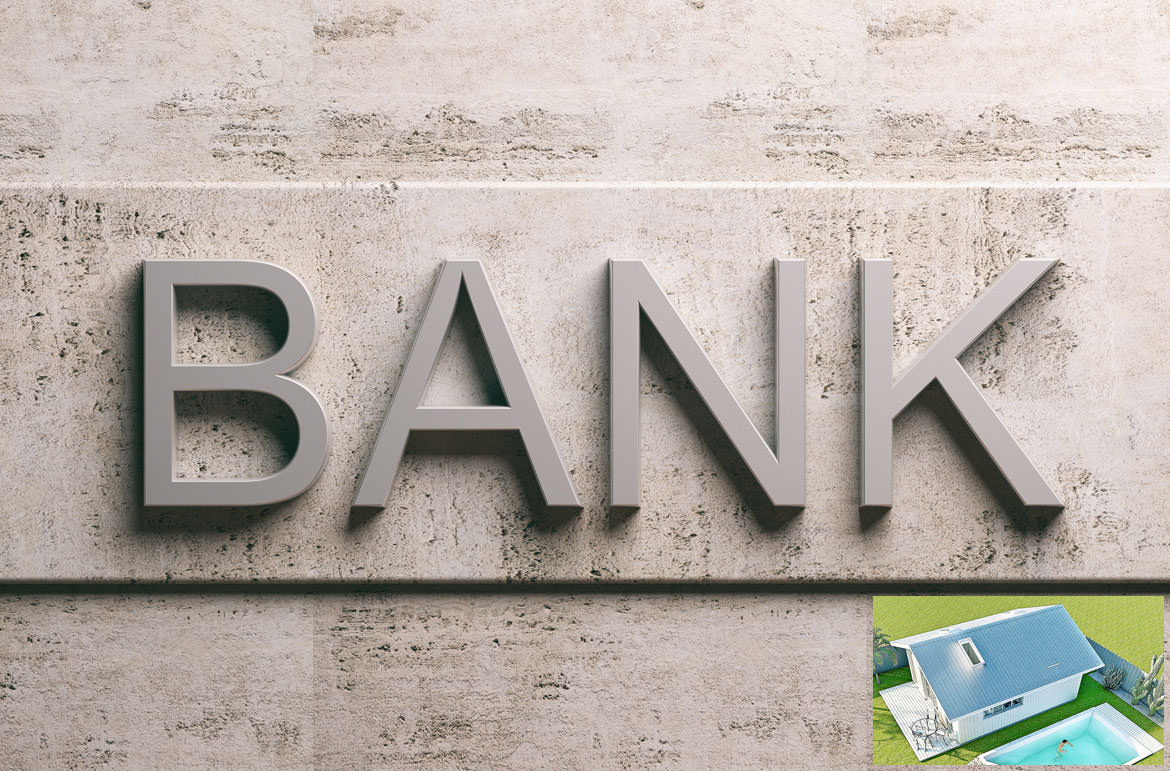
If you are thinking about adding a granny flat to your main home, you may also be thinking about how to find the cash to cover the costs for this build. Is it hard to obtain finance for a granny flat?
This depends on your unique situation, however; broadly speaking, it can be straight forward to get a loan to build a granny flat.
I will let you know what documents the banks need to see, and if you can use the equity in your current home.
I will discuss how payments work when hiring a builder, and owner builder finance for granny flats. Lastly, I will discuss if you have private equity options instead of using banks.

Sitting down with a banker or broker will help with your individual circumstance
Let’s begin, so you can obtain finance and start building.
DON'T PAY A FORTUNE FOR YOUR GRANNY FLAT. Find out how to deal with council and build a granny flat for the lowest cost possible. Learn More.
What Documents Do the Banks Need to See?
To get a loan for a granny flat, the bank may ask you to provide evidence of these things:
- Sufficient equity in your existing property (see sub-heading “Can You Use the Equity in Your Current Home?” for more information).
- Adequate income to support the new loan, and stable employment.
- A convincing credit history, and above average credit score.
If applying for an owner builder loan, you will likely need to apply more documents than for a traditional loan. These include:
- Your building plans / floor plans.
- A broken-down estimate of the total cost of construction.
- A copy of your owner builder insurance (if applicable).
- A copy of your owner builder certificate.
- A copy of Council approved plans (when attained).
Note: All banks have different lending principles, so it’s important that you check with them directly, so you know what they need prior to applying for a home loan for your granny flat.
Can You Use the Equity in Your Current Home?
You can use the equity in your current home, if you have enough. Equity is the difference between what your home is currently valued at, and what is left owing on your mortgage.
This will assist you in getting the money you require, as you may be able to either increase or refinance the loan you already have on your current home. Though, it’s important to note that banks will typically only lend 80% of the equity that you have available.
How do you access your equity? Well, if you have built up enough equity, you can either choose a line of credit, or cash out.
The difference between these include that:
- A line of credit is easier to keep track of than cash out, as it is an individual mortgage, so you can see the expenses you have collected while building the granny flat.
- You must submit a new application and documents to your bank to obtain a line of credit. This can take a lot of time for the bank to then form an opinion on your application. Whereas, cash out means just put extra money on top of the mortgage you already have, and as you are an existing customer, you will not need to provide as much documentation for your application.
Don’t have enough equity? Well, there are other ways to obtain finance. Consider owner-builder finance, which I will talk about soon.
How do Payments Work When Hiring a Builder
If, when building your granny flat, you want to be the project manager, and just hire a builder instead of using a “building company”, there are three ways they’re normally paid. All are staggered payments – so these can be by:
- The Hours they Worked,
- Jobs Completed, or
- Weekly.
Let’s delve into each of these a little further.
Paying by Hours Worked
This is a way of being paid that your builder will most likely be familiar with, and is a particularly good way to pay them if you:
- Intend on helping them with some of the labour, and
- Know they won’t be on site on a daily basis, as they have other jobs they are also working at.
Paying by Jobs Completed
This is a good way to pay if you want to partake in the labour, and it doesn’t worry you if the builder takes a bit longer to finish.

Doing the figures to make sure it all works for you is the most important thing
For example, it’s common to hire is a roofer to do the roof, as this is a hard job to do yourself. So, you can agree on a price with them for this one job. And if it takes them over a week to do this, it won’t stress you, as you know you’re sticking to your budget for this job.
Just be sure you both have handled the expectations of how long the job will take.
Paying Weekly
You might need a builder by your side, so they can give you a hand with the work, or advice on bits you are unsure about.
In this situation, you may agree to pay them the amount “X” every week for a number of weeks. Just be sure both you and the builder are happy with this figure, and you have a contract stating you have agreed certain jobs will be finished by a certain time.
For other tips on choosing a builder, see my post, “Granny Flat Builders – The Ultimate List”.
As to why staggering payments works, let’s move on to owner builder finance.
Owner-Builder Finance for Granny Flats
The majority of banks only finance construction of new homes or granny flats by licensed builders.
So, if applying for a loan as an owner-builder, most construction loans are only available, IF… you have equity, savings, or a guarantor.
That’s where I’m here to help.
There are other options available. See IntelliChoice for their Owner Builder loans.
Or see St.George, and their Residential Building loans.
Some things you need to know about this type of loan from banks:
- They might have a valuer complete a valuation. The value of completed your construction will determine how much they lend you. This will be the lesser amount of your land plus the total of the estimated cost of construction, or the on-completion value of your property.
- Require, to help determine your loan amount and repayment ability:
- A fully completed Owner Builder Estimate of Construction Costs form. These can be attained from any St.George bank.
- In writing, your schedule of progress payments. This should show how much money you require as you progressively build, and when. It should also describe the works you intend on completing at each stage of the project, to help explain the reason for these payments. (Note: This article helps explain exactly what needs to be done at each stage of the build, and paying your builder in stages helps release the money when necessary). St.George will review your schedule, and their valuer will use it to assess your projected cash flow for your progress payments, based on this schedule, subject to negotiation and final approval.
- Plans approved by Council or a private certifier and specifications, as well as any conditions of approval that Council may have specified. If yet to submit your plans, to finish the assessment with St.George, instead supply them with a copy of those identical to those that must be submitted to Council. This will help them get the ball rolling, so they can conduct the valuation. But you will still be required to give them Council’s approval and conditions of approval before they will release to you any funds.
- In writing, a description of all work you are to carry out as owner-builder, and all family, friends, and sub-contractors, including any tradespersons, and plumbing, electrical work, brick laying, carpentry, roof, wall and floor tiling, gas fitting, painting, and concreting. Highlight all works to be completed at no cost, and describe all work to be done at a discounted rate by yourself, friends or family. Include full costs of works to be done by qualified tradespeople, and their quotes.
- Will provide you with finance if you have already started the job, but will require different paperwork again. So, keep all receipts just in case.
- Will have their nominated valuer carry out at least 4 inspections during construction (completion of slab/footings piers, completion of frame including roof, completion of brickwork and external lining, and completion of project), prior to each progress payment being made. The cost of these inspections varies, dependent upon which State/Territory you are building the granny flat in.
Once a bank has completed your valuation and assessed your application, they may issue you with a Loan Agreement, which might include a Progress Payment Calculation Schedule. This shows how they will progressively pay you at the stages that were determined by you. When they have completed their inspection, and confirmed you have followed the floor plans, the funds will be released.
Are There Private Equity Options Instead of Using Banks?
Unfortunately, not as yet.
At this stage, private equity funds are typically only made available to wholesale investors, as they have an exclusive fee structure.
To qualify as a wholesale investor, a potential investor needs to have a certificate imparted by a qualified accountant, which confirms they can meet one of the classifications listed below:
- Make an investment of at least $500,000 in a trust.
- If investing under $500,000, provide a certificate from a qualified accountant, attained within the two preceding years, that they have net assets that are a minimum of $2.5 million, or had a gross income in the two-prior financial years, that was at least $250,000.
- Be a “professional investor” or a “Sophisticated Investor” (as described in the Corporations Act).
- Be an “experienced Investor” – that is, a person or organisation who has had notable dealing and familiarity with investment, in particular in relation to unlisted property trusts, and has gained this qualification from a Trustee or AFSL Licensee.
As you see, this isn’t an easy target to reach.
Conclusion
You can use equity, savings, a guarantor, or owner-builder finance, and lenders will lend a good percentage of the value of your property so you can build your granny flat.
Every build has its own financial fingerprint – so your final percentage depends on your current financial situation. But I hope this post has helped you start your journey towards finding the best option for you to obtain finance, and start building.
You may also be interested in reading, “Granny Flat Investments – Are They a Good Investment or Not?”.











